Decoding the Meaning of the Anarchy Symbol: A Step-by-Step Guide
The anarchy symbol, a circled 'A,' signifies the principles of anarchism, opposing hierarchical structures and state control. Emerging in the 19th century, it was popularized by thinkers like Proudhon and Bakunin advocating self-governance and equality.
Throughout history, it has been adopted by various political and cultural movements, especially in the punk rock scene of the 1970s, symbolizing resistance and anti-establishment sentiments. Frequently misunderstood as a symbol of chaos, it originally implies that true order exists without state control.
Exploring this symbol reveals its deep historical roots and evolving cultural significance.
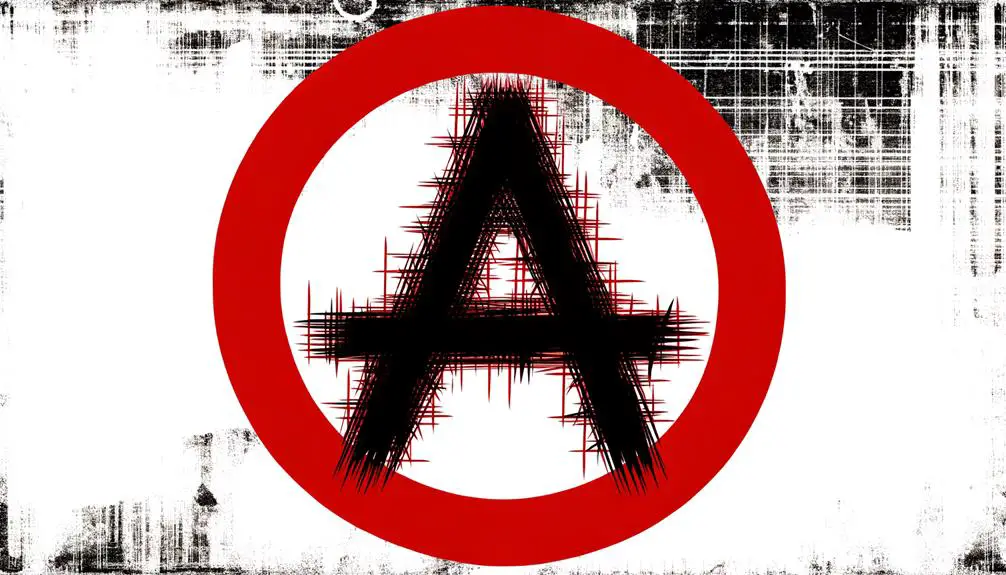
Key Takeaways
- The anarchy symbol, a circled 'A,' signifies resistance against hierarchical structures and state control, promoting self-governance and individual autonomy.
- It originated in the 19th century as a visual representation of the principle 'Anarchy is Order,' opposing authoritarian regimes and industrial capitalism.
- The symbol was popularized by punk rock in the 1970s, becoming a global emblem of rebellion and countercultural defiance.
- Modern interpretations associate the symbol with anti-authoritarianism and resistance within various social and political movements.
- Despite being misunderstood as representing chaos, the anarchy symbol historically advocates for a society without hierarchical governance.
Historical Origins
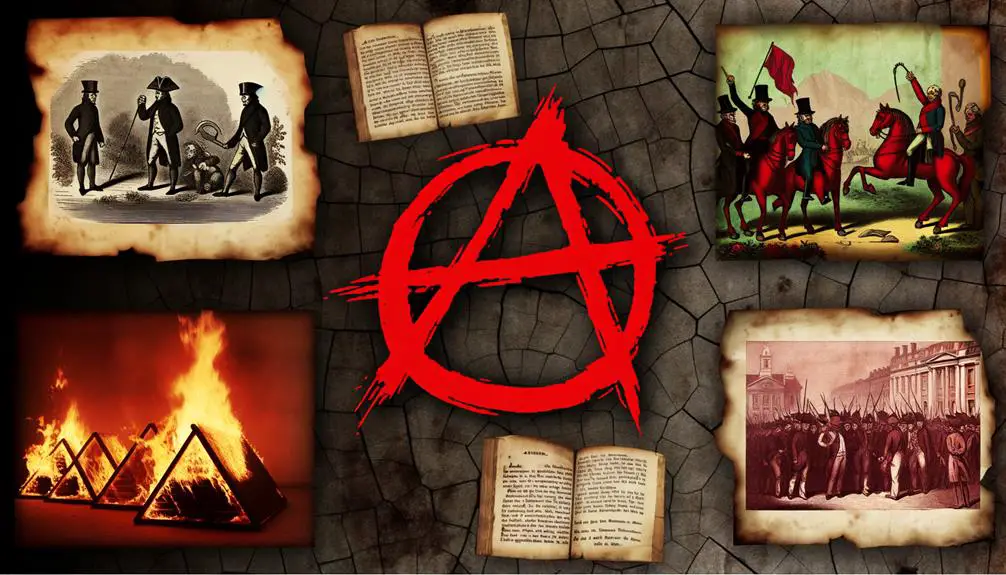
The anarchy symbol, often represented by an 'A' enclosed within a circle, finds its historical origins in the political and social upheavals of the 19th century. This period was marked by significant discontent with authoritarian regimes and burgeoning industrial capitalism.
Anarchism emerged as a response, advocating for a society free from hierarchical structures and state control. Influenced by thinkers like Pierre-Joseph Proudhon and Mikhail Bakunin, the symbol encapsulated the core principle of ‘Anarchy is Order.' The encircled 'A' gained prominence as it visually communicated a unified ideology of resistance and self-governance.
Its cultural significance lies in its enduring representation of dissent, embodying a quest for freedom and equality, resonating with various anti-establishment movements over time.
Symbolic Evolution
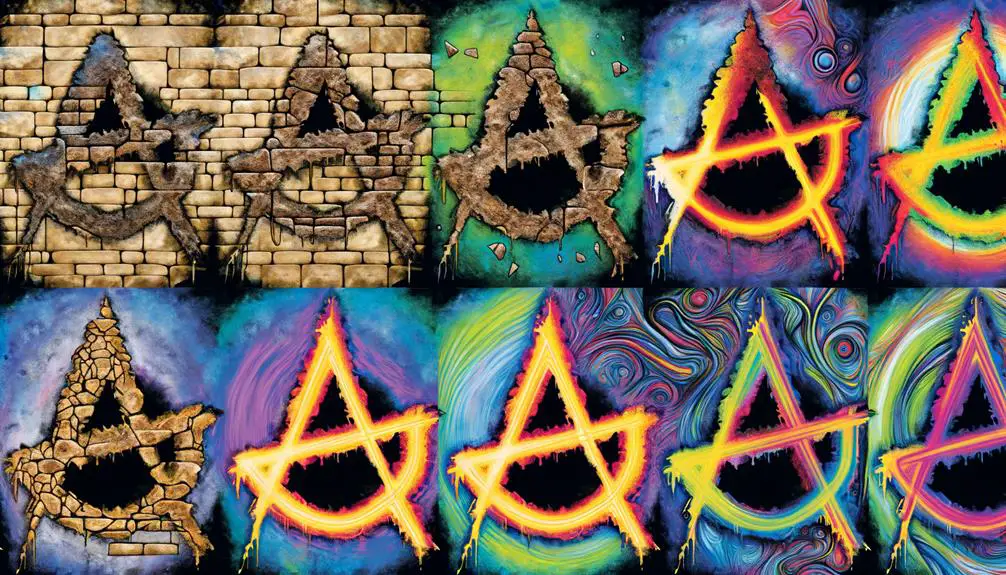
The evolution of the anarchy symbol is deeply intertwined with its historical context and origins, reflecting the changing dynamics of political movements and their agendas.
Over time, the symbol has been adopted and adapted by various cultural groups, each imbuing it with distinct meanings and significance.
This transformation underscores its enduring relevance and the fluid nature of its representation in societal discourse.
Historical Context and Origins
Emerging from the socio-political upheavals of the 19th century, the anarchy symbol underwent significant evolution, reflecting the shifting ideologies of anarchist movements.
Initially, the symbol was not universally recognized; early anarchists used various insignias to denote their resistance to hierarchical structures.
By the mid-20th century, the circled 'A' became emblematic, its origins attributed to the French anarchist organization, Fédération Anarchiste.
The symbol's simplicity and universality encapsulated the core anarchist principle of 'anarchy is order,' devoid of imposed hierarchies.
Historically, the symbol's evolution mirrors the broader cultural and philosophical shifts within anarchism, adapting to resonate with contemporary struggles for autonomy and egalitarianism.
Therefore, it signifies a legacy of dissent, resilience, and a quest for a stateless society.
Political Movements and Usage
Throughout the latter half of the 20th century, the anarchy symbol became a potent emblem within various political movements, symbolizing resistance and the pursuit of radical social change. Its adoption by punk subcultures in the 1970s and 1980s emphasized a rejection of mainstream societal norms and governmental authority.
Additionally, the symbol was prominently featured in anti-globalization protests and environmental activism, representing a critique of corporate power and ecological degradation. The anarchy symbol's utilization in these contexts underscores its role as a visual shorthand for anti-establishment sentiments.
Historically, its presence in these movements reflects a deep-seated desire for autonomy and systemic overhaul, marking it as a culturally significant icon for those advocating for profound societal transformation.
Cultural Adaptation and Influence
As the anarchy symbol proliferated through various political movements, its cultural adaptation and influence evolved, reflecting broader societal shifts and the dynamic interplay of symbolism within different contexts.
Initially rooted in anarchist ideology, the symbol transcended its political origins to become an emblem of countercultural expression.
During the late 20th century, it was appropriated by punk rock subcultures, signifying rebellion and anti-establishment sentiment.
In addition, its incorporation into fashion and art highlighted its versatility and resonance within contemporary culture.
The symbol's malleability underscores its enduring relevance, enabling it to articulate dissent across diverse platforms while maintaining its core message of challenging authority.
This evolution illustrates the profound impact of cultural forces on the interpretation and propagation of symbolic imagery.
Philosophical Foundations

Rooted in the principles of individual autonomy and skepticism towards hierarchical structures, the philosophical foundations of the anarchy symbol trace back to 19th-century anarchist thought and its critique of state power and institutionalized authority.
Prominent thinkers like Pierre-Joseph Proudhon and Mikhail Bakunin championed the idea of a society organized through voluntary cooperation rather than coercive governance. This intellectual backdrop underscores the symbol's deeper meaning, representing a commitment to dismantling oppressive systems and promoting egalitarianism.
Historically, the symbol emerged as a visual shorthand for these transformative ideals, encapsulating a radical rethinking of societal organization.
Culturally, it resonates as a symbol of resistance and empowerment, advocating for a world where freedom and justice are paramount.
Political Implications
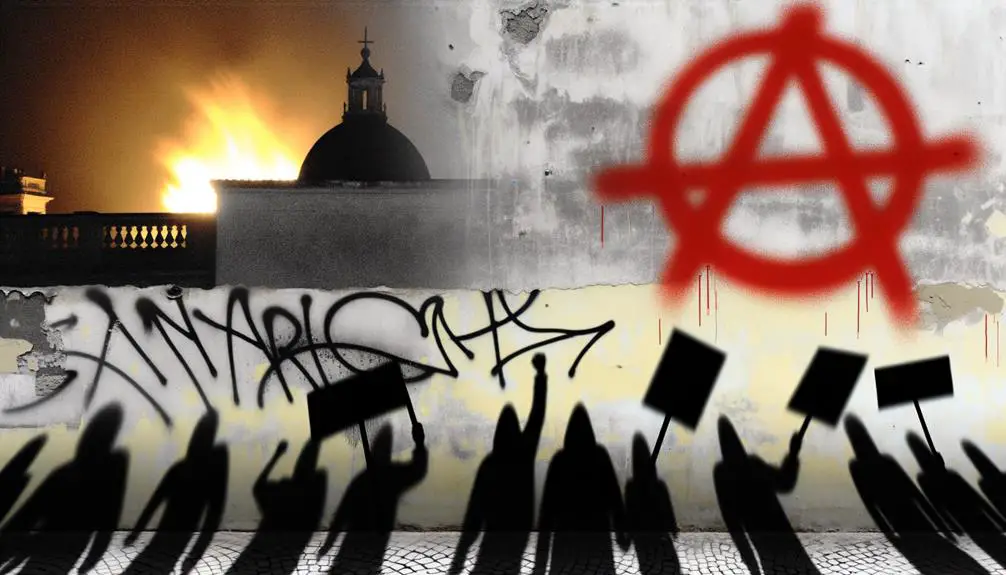
The political implications of the anarchy symbol are deeply rooted in its historical evolution, which traces back to 19th-century radical movements advocating for stateless societies.
As a visual representation, it wields significant symbolic power, influencing both public perception and political discourse.
In modern times, the symbol has been appropriated by various political movements, reflecting a wide spectrum of anti-establishment sentiments.
Historical Context and Evolution
Emerging in the late 19th century, the anarchy symbol has been intrinsically linked to political movements advocating for a stateless society and the dismantling of hierarchical structures. Rooted in the ideological currents of anarchism, which gained momentum through the works of thinkers like Proudhon, Bakunin, and Kropotkin, the symbol evolved as a visual shorthand for radical dissent.
Originally, the encircled 'A' represented 'Anarchy is Order,' reflecting a belief in self-managed, egalitarian communities. Over time, it became emblematic of broader anti-authoritarian struggles, particularly during the social upheavals of the 1960s and 1970s. Its cultural significance deepened as it was adopted by various subcultures, intertwining with punk movements and civil rights activism, continually reshaping its political implications.
Symbolic Power and Influence
As the anarchy symbol transcended its historical origins, it amassed significant symbolic power, becoming a potent emblem of resistance and a catalyst for political discourse on the legitimacy of authority and state power.
Rooted in the anti-authoritarian ideologies of the 19th-century anarchist movements, the symbol's adoption by various counterculture groups underscores its enduring relevance. The circled-A encapsulates the struggle against perceived oppressive systems, advocating for self-governance and individual autonomy.
Its visual simplicity and profound message have enabled it to permeate diverse cultural and political landscapes. Historically, the symbol's presence in protest movements and its association with direct action have sparked debates on the nature of power, governance, and societal structures, reinforcing its role as a powerful ideological tool.
Modern Political Movements
In contemporary political movements, the anarchy symbol manifests as both a critique of established power structures and an emblem of the pursuit of radical social transformation. Historically rooted in 19th-century anarchist philosophy, it has evolved to represent various anti-authoritarian and anti-capitalist ideologies.
Modern activists employ this symbol to challenge systemic inequalities, advocate for decentralized governance, and promote direct action. Its cultural significance is underscored by its adoption across a spectrum of social justice initiatives, from environmental activism to anti-globalization protests.
The symbol serves as a unifying visual lexicon for those advocating for a society free from hierarchical constraints, resonating with a global audience committed to revolutionary change and the dismantling of oppressive institutions.
Cultural Impact

The anarchy symbol, often recognized as a circled 'A,' has permeated various cultural landscapes, symbolizing resistance and anti-establishment sentiments throughout history. Its adoption by punk rock in the 1970s transformed it into a global emblem of rebellion and countercultural defiance.
This symbol has been emblazoned on album covers, clothing, and graffiti, reflecting a deep-seated discontent with societal norms. In literature and cinema, the anarchy symbol frequently appears as a motif representing chaos and the questioning of authority.
Moreover, its presence in art underscores its role as a powerful visual protest against conformity. Through these cultural expressions, the anarchy symbol has transcended its political origins, embedding itself in the fabric of societal critique and artistic expression.
Modern Interpretations
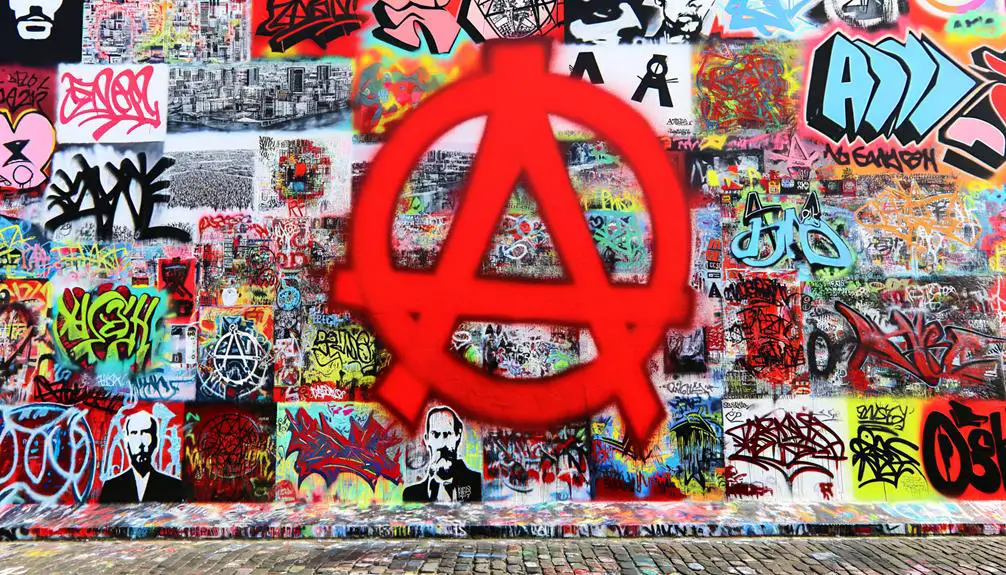
Modern interpretations of the anarchy symbol reveal its evolving significance as a multifaceted icon within contemporary social and political movements. Historically rooted in 19th-century anarchist ideals, the symbol has transcended its original context to embody broader themes of anti-authoritarianism and resistance.
Today, it is frequently adopted by diverse groups advocating for social justice, environmental activism, and digital freedoms. This shift reflects a dynamic reinterpretation where the symbol serves as a unifying emblem for varied causes challenging systemic power structures.
Its cultural significance is continuously redefined, illustrating the adaptability of anarchist principles in addressing modern issues. The symbol's persistent relevance underscores its capacity to inspire collective action and articulate dissent in an increasingly complex global landscape.
Misconceptions

Despite its widespread recognition, the anarchy symbol is often misunderstood and mischaracterized, leading to significant misconceptions about its true meaning and historical context. Many associate the symbol solely with chaos and lawlessness, overlooking its roots in political philosophy.
Historically, anarchism advocates for a society without hierarchical government, promoting voluntary cooperation and mutual aid. The symbol, an 'A' for anarchy within an 'O' for order, signifies 'anarchy is order,' a concept central to its ideology.
Misinterpretations also arise from its appropriation by subcultures and movements disconnected from its original intent, further distorting public perception. Recognizing these misconceptions is vital for a nuanced understanding of the anarchy symbol's cultural and historical significance.
Global Variations
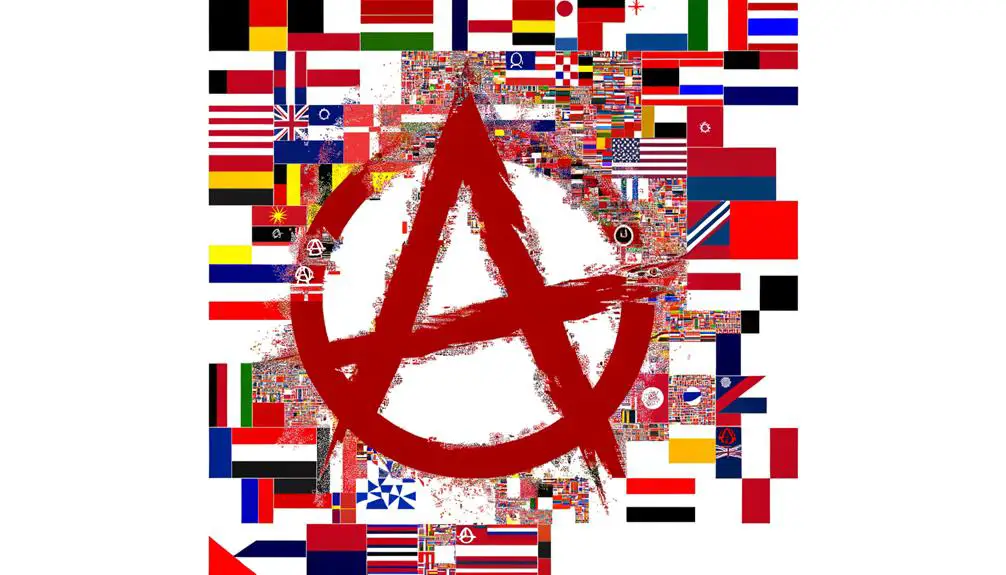
Across different cultures and regions, the anarchy symbol has evolved uniquely, reflecting varied interpretations and adaptations influenced by local historical and political contexts.
In Europe, particularly during the Spanish Civil War, the symbol became emblematic of the anarchist fighters opposing fascism.
In Latin America, it merged with indigenous struggles, symbolizing resistance against colonial and neo-colonial oppression.
Meanwhile, in the United States, it gained prominence in the 1960s and 70s, aligning with countercultural movements and civil rights activism.
In East Asia, particularly Japan, the symbol intersects with anti-establishment sentiments and radical art movements.
Each adaptation underscores the symbol's inherent flexibility, enabling it to resonate with diverse causes and communities worldwide. Its global variations reflect its profound cultural significance and enduring legacy.
Future Perspectives

As the anarchy symbol continues to evolve across diverse cultural landscapes, its future perspectives will likely be shaped by emerging global challenges and shifting socio-political dynamics.
Historically rooted in resistance and anti-establishment sentiment, the symbol may increasingly represent a broader spectrum of dissent in response to issues like climate change, economic inequality, and digital surveillance.
Its cultural significance could expand as marginalized communities and activist groups adopt it to voice their struggles and aspirations.
The symbol's adaptability suggests it will remain a potent emblem of defiance and autonomy, reflecting the ongoing quest for a more just and equitable society.
Consequently, its future iterations could serve as a barometer for the evolving landscape of global activism.
Conclusion
The anarchy symbol, a historically rich icon, reflects deep philosophical foundations and political implications. Its evolution showcases a tapestry of cultural impacts and modern interpretations, though often shrouded in misconceptions.
Global variations add layers of complexity, highlighting the symbol's enduring relevance. As the saying goes, 'the only constant is change,' and the future perspectives on the anarchy symbol will unquestionably continue to shape and be shaped by socio-political landscapes worldwide.






